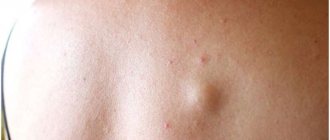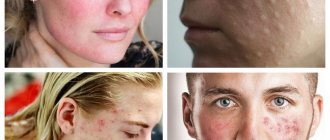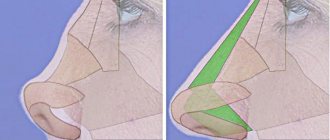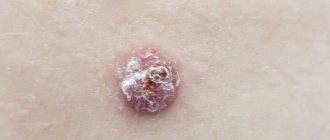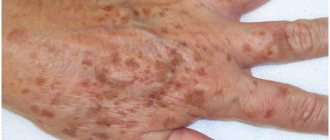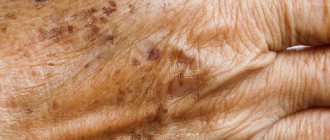What is erysipelas or erysipelas?
This is one of the most unpleasant inflammatory diseases, which mainly affects the face and limbs. It not only brings with it fever and pain, but also causes a lot of inconvenience.
Erysipelas on our patient’s leg
The causative agent of erysipelas is staphylococcus, a bacteria that can destroy the vital activity of cells. Usually the human body is quite resistant to this disease. However, during periods of decreased general and local immunity, erysipelas may appear with varicose veins. Even the leading and best European specialists are familiar with this disease first-hand. Both surgeons and dermatologists in public clinics and phlebologists in private city medical centers encounter erysipelas in their patients. Every year, thousands and thousands of patients in Moscow and the Moscow region seek help with signs of erysipelas. Only a fraction of them receive really good treatment, even in Moscow. The best solution when symptoms of erysipelas appear is to find a good specialist who will conduct modern diagnostics and prescribe adequate treatment.
1.General information
Erysipelas, erysipelas - these and similar terms are used mainly in Slavic languages; in medical Latin and most Western European languages, the original ancient Greek name erysipelas was fixed, i.e. "red skin" In the old days there were also synonyms “holy fire”, “Saint Anthony’s fire” or, in Russian, “Antonov’s fire”, although some dictionaries define this term as one of the designations for gangrene.
Erysipelas is an acute skin infection (or recurrent exacerbation of a chronic one), the hallmarks of which are swelling and erythema - a bright red, “fiery” hue of the affected area. In general, erysipelas is one of the most common human infectious diseases; the localization of inflammation can be very different, however, due to the peculiarities of the anatomical structure, the disease often manifests itself on the skin of the face, primarily in the soft tissues of the external nose (vestibule, wings, nasal walls): a high concentration of sebaceous glands, capillaries and nerve endings facilitates the penetration and activation of the pathogen .
A must read! Help with treatment and hospitalization!
Symptoms of erysipelas of the lower extremities
- quite noticeable headache
- high temperature, which is very difficult to bring down
- chills
- vomiting like food poisoning
- burning sensation on the skin
- severe redness on the skin
- The area of skin affected by erysipelas differs from healthy skin - it is either convex or separated by a small ridge.
If you notice such symptoms, you should immediately consult a doctor so as not to start the disease, because erysipelas can become more complicated.
This is what erysipelas looks like
If erysipelas is a consequence of varicose veins, then such a complication may be thrombophlebitis, in which inflammation spreads to the wall of the veins, and then a blood clot forms in the lumen of the vein. Another complication of erysipelas with varicose veins is tissue necrosis, leading to the appearance of trophic ulcers that are difficult to treat.
Erysipelas in children
Erysipelas are rare in children. In older children, the disease is mild. The focus of erysipelas can occur in different places. The erythematous form develops more often. The prognosis is favorable.
In children under one year of age, erysipelas is more severe. Foci of inflammation often appear in areas of diaper rash and on the face, sometimes spreading to other parts of the body. With the phlegmonous form of the disease, sepsis can develop, with erysipelas of the face - meningitis.
Erysipelas develops severely when streptococci penetrate into the umbilical wound in newborns. The process quickly spreads to the child’s back, buttocks and limbs. Intoxication increases, body temperature rises significantly, and convulsions appear. Some patients develop sepsis. Mortality from erysipelas in newborns is extremely high.
Rice. 24. The photo shows erysipelas in children.
Forms of erysipelas
Mild form of erysipelas
It is characterized by a short-term rise in temperature, which usually does not exceed 39 degrees. The affected area of skin becomes red, swollen and painful to the touch. There is a general feeling of weakness.
Moderate form of erysipelas
The temperature is quite high (above 39 degrees) and lasts for a long period of time, up to 5 days. In addition to redness, blisters and hemorrhages form on the affected area of the skin. You feel a severe headache, nausea and vomiting.
Severe form of erysipelas
The temperature remains high for about a week, and even convulsions are possible. The affected area of skin is covered with blisters with cloudy liquid and hemorrhages. In addition to vomiting and general weakness, there is also the danger of developing septicopyemia (blood poisoning).
Bullous form of erysipelas
The incubation period lasts from several hours to 2 days. A characteristic sign is an acute onset with general symptoms (fever above 38°C, chills, nausea, vomiting). In 70-80% of cases, lesions are located on the lower extremities (lower legs), in 5-20% on the face (bridge of the nose, periorbital region and cheeks), less often in the upper extremities, torso and neck. Localized lesions of the auricle (Milian's ear) have been described. and penis. There are several clinical forms of the disease:
Erythematous (typical) erysipelas
It is a painful lesion of bright red color of different sizes, swollen, dense (“orange peel”), with a progressively raised border, often with edges in the form of “flames” or “notches”, clearly different from the normal surrounding skin.
Regional lymph nodes are enlarged, swollen, and lymphangitis is often observed. When infected with Haemophilus influenzae, the color of the lesion is purple-purple. In some cases, petechiae and ecchymoses (erythematous-hemorrhagic form) are observed on the surface of the lesions. When adequate treatment is started, the process quickly regresses with minor peeling at the site of erythema.
Bullous erysipelas
It is characterized by the appearance of blisters of various sizes against the background of erythema, filled with serous contents within 24-72 hours from the onset of the disease, which quickly open with the formation of erosions and brown crusts. In some cases, the contents of the blisters are hemorrhagic in nature (bullous-hemorrhagic form). With late onset or inadequate treatment, erosions can transform into trophic ulcers.
Phlegmonous erysipelas (cellulite)
It is characterized by the penetration of infection and damage to the subcutaneous fat with the appearance of dense edema and diffuse erythema. Characterized by severe general symptoms (fever, vomiting, headache).
Necrotizing erysipelas (necrotizing fasciitis)
It is manifested by the appearance of extensive areas of necrosis in the lesions in the form of black areas and the appearance of extensive ulcers of irregular shape.
Recurrent erysipelas
It is observed in 30% of cases, mainly in persons with venous insufficiency or lymphedema. Its characteristic feature is the absence of general symptoms and fever.
Complications:
- Deep vein thrombosis
- Septic shock with fatal outcome
- Metastatic abscesses in various organs
- Infective endocarditis
Modern treatment of erysipelas
To avoid the transition from mild forms of the disease to more complex ones, as well as the possible complication of erysipelas in the lower extremities resulting from varicose veins, it must be treated promptly and adequately. Of course, this disease, especially its initial stages, is not a reason for hospitalization, but if erysipelas is advanced, the doctor will suggest hospital treatment as the best solution.
A number of antibiotics are prescribed as drug therapy, since staphylococcus is a bacterium. In addition, various physical procedures are used to dry out the inflamed and non-healing area of the skin, for example, ultraviolet irradiation. Problem areas can also be treated using laser therapy. Modern therapy for erysipelas includes the local application of antiseptic dressings and solutions. This is a very important and even leading component of treatment, as it gives a very good medical effect.
Very often, after the first erysipelas, a relapse occurs. The first time, erysipelas mainly affects only one, specific area of the soft tissues of the face or lower extremities. But for the second time it can affect a large area, causing a significant inflammatory reaction. To protect yourself from this disease, it is necessary to treat varicose veins, which are often the root cause of erysipelas on the legs. If normal blood circulation is restored, the skin will receive enough nutrition, therefore, necrosis and various ulcers will not appear. Of course, good hygiene is also the key to avoiding erysipelas.
Leading modern European studies speak about the polyetiological nature of erysipelas. That is, the disease is caused by a complex of factors. These include disorders of the immune status, diseases of the lymphatic and venous systems. Residents of Moscow and the Moscow region are also significantly susceptible to erysipelas. A good, competent doctor who knows innovative techniques, using modern medications, will be able to stop erysipelas without much difficulty. It is much more difficult to prevent relapse. Here it is necessary to understand the reason that caused the erysipelas. In Moscow and the Moscow region, innovative technologies for comprehensive examination of patients are more accessible. Therefore, it is usually easier to find out the cause of erysipelas in a metropolis like Moscow. Various public and private city medical centers today are engaged in the diagnosis and treatment of erysipelas, diseases of the veins and lymphatic system. However, you must always contact good doctors, European-level professionals who know and apply modern diagnostic and treatment methods, even in Moscow.
Erysipelas
There are 20 types (serogroups) of streptococci. The most significant of them are streptococci of serogroups A, B, C, D and G. Beta-hemolytic streptococci of group A (Streptococcus pyogenes) are the cause of many dangerous diseases in humans - pustular diseases of the skin and soft tissues (abscesses, cellulitis, boils and osteomyelitis) , tonsillitis and pharyngitis, bronchitis, rheumatism, scarlet fever and toxic shock. Erysipelas can be caused by any type of group A streptococcus.
Bacteria have a round shape. They are often arranged in chains, less often in pairs. They reproduce by dividing in two.
- In the external environment, including sputum and pus, the bacteria persist for months and survive at low temperatures and freezing.
- High temperature, sunlight and disinfectant solutions have a detrimental effect on microbes.
- Streptococci show high sensitivity to antibiotics, resistance to which they develop slowly.
Streptococci secrete a number of endo- and exotoxins and enzymes that cause their damaging effects.
Rice. 2. Streptococci have a round shape. They are often arranged in chains, less often in pairs.
Rice. 3. Beta-hemolytic streptococci of group A, when growing on blood agar, form zones of hemolysis (light halos) that are 2 to 4 times larger than the diameter of the colonies themselves.
Rice. 4. When growing on nutrient media, colonies of streptococci are shiny, drop-shaped, or gray, matte and granular with uneven edges, or convex and transparent.
Prevention
For preventive purposes, it is better to adhere to certain rules:
- promptly treat all painful conditions of the skin;
- observe personal hygiene rules, especially after visiting crowded places;
- do not allow infectious agents to get into small scratches or wounds;
- treat all violations of the integrity of the skin.
- timely treatment of fungal skin infections and lymphovenous insufficiency.
What does a erysipelas look like on your face?
The disease “erysipelas” on the face is often expressed through visual signs:
- Disruption of lymph flow, as streptococcus affects the lymphatic vessels.
- Cracks appear.
- Soreness in inflamed areas.
- A red spot appears that rises above the level of the skin.
- Erysipelas on the face always have clearly defined boundaries.
- After some time, the spot grows and becomes hot.
- In advanced stages, blisters and hemorrhages may appear.
With erysipelas located in the face area, the inflammatory process can spread in the following areas:
- ears;
- nose;
- ear opening;
- mouth;
- cheeks;
- rarely located under the hairline.
In another article you can see what erysipelas on the leg looks like.
Photo
To determine the visual symptoms of erysipelas, use the provided photographic material.
Symptoms
The initial symptomatic manifestations of erysipelas are:
- headache and general weakness;
- temperature rise up to 40 degrees;
- aches in the joints, lower back, muscles;
- burning sensation;
- itching;
- gagging;
- swelling in the damaged area;
- tachycardia.
In severe conditions the following are observed:
- vomit;
- convulsions;
- rave.
Provoking factors
The development of erysipelas on the face can be provoked by:
- stress loads;
- long-term fatigue;
- increased sports loads;
- sudden temperature changes;
- mechanical skin defects;
- Tan.
One of the obvious reasons may be:
- Reduced immunity.
- Chronic somatic diseases.
- Unbalanced diet.
- Alcohol abuse.
- Streptococcus infection.
